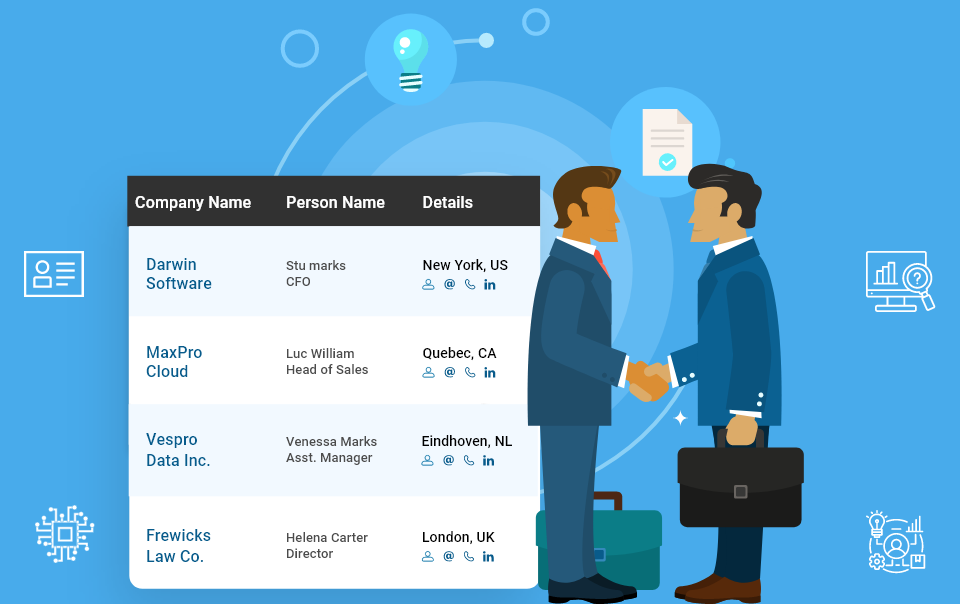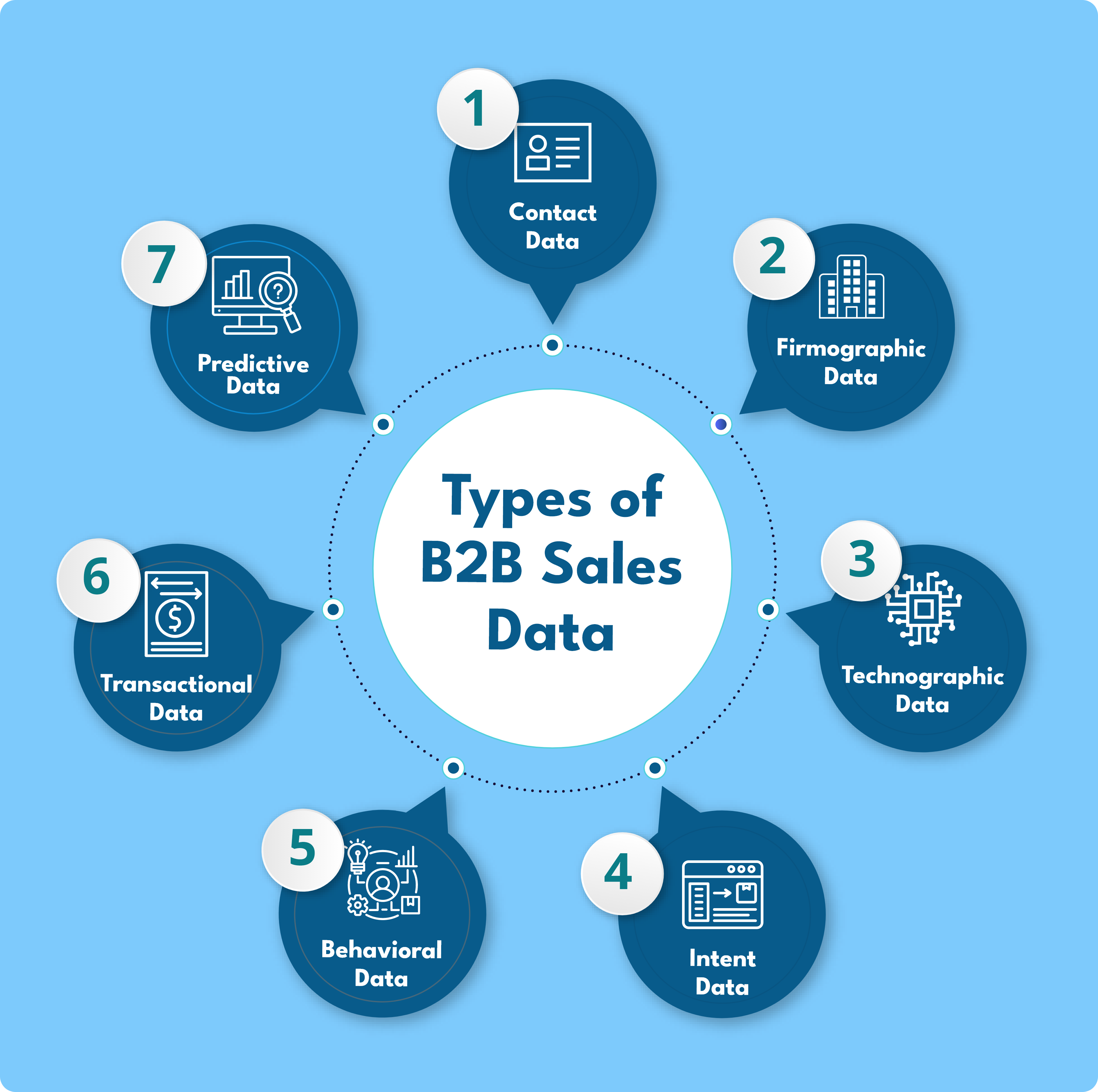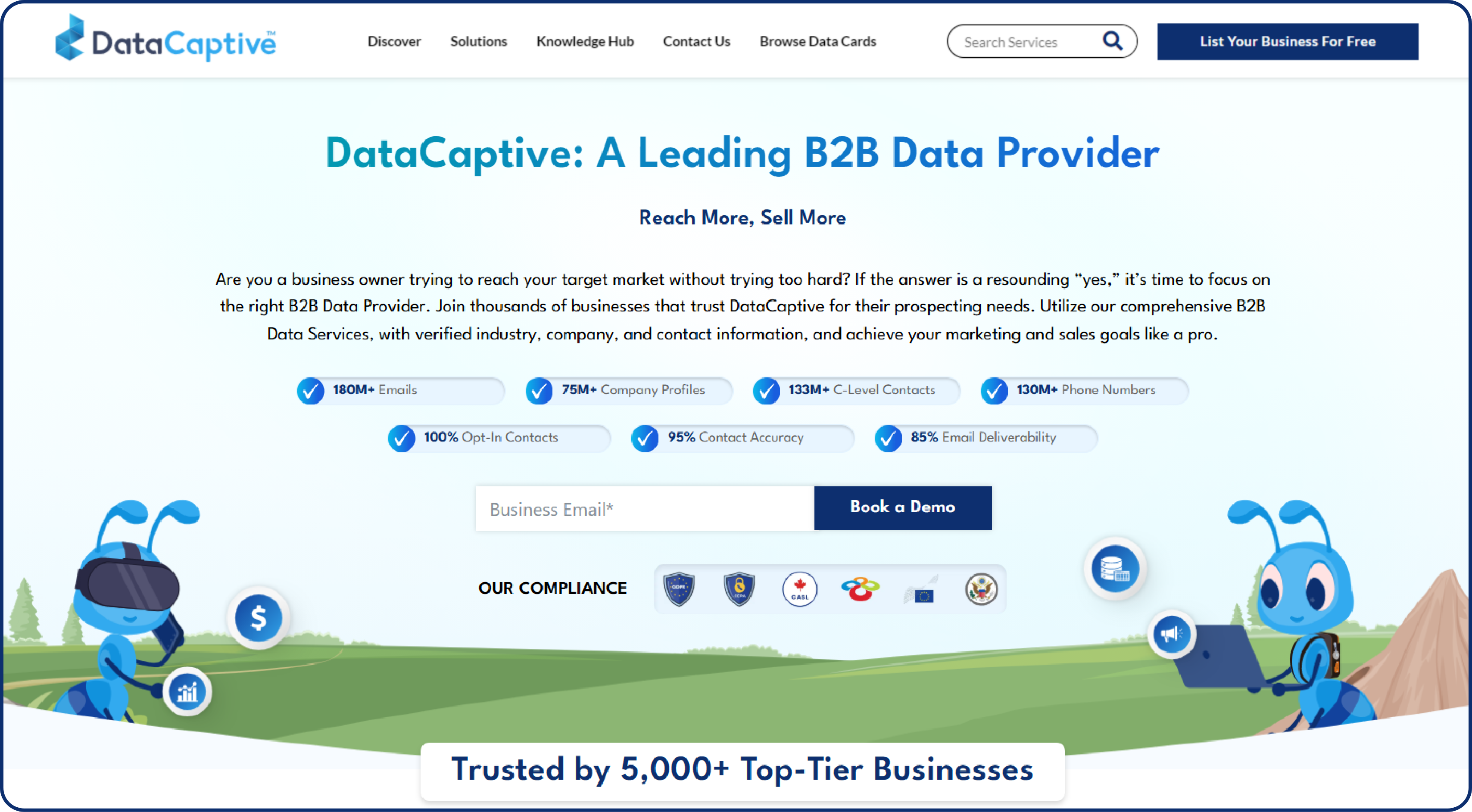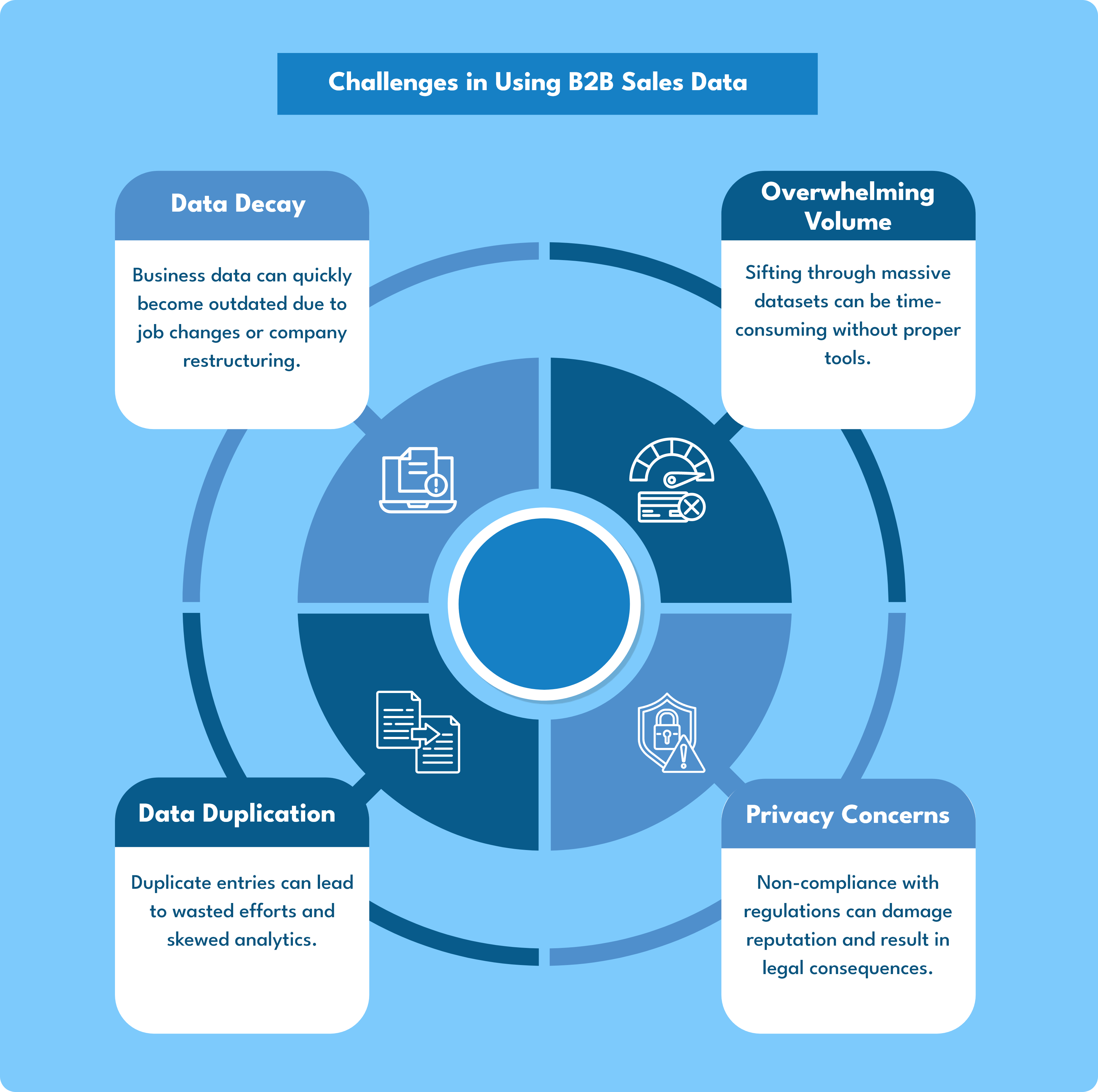Subscribe to Our Newsletter
Stay updated with the latest tips and strategies. Get additional discounts and alerts on offers.

In the world of business-to-business (B2B) sales, data reigns supreme. B2B sales data refers to the vast array of information that businesses collect and utilize to identify prospects, understand customers, and drive sales growth. Leveraging accurate and comprehensive B2B sales data can empower organizations to streamline their sales processes, enhance lead generation, and improve customer engagement.
This article delves into the definition, types, and sources of B2B sales data while offering actionable best practices for effective use. Additionally, we highlight how DataCaptive, a trusted B2B data provider, can be a valuable partner in achieving sales success.
B2B sales data is information about businesses, their decision-makers, and potential leads used to support sales and marketing activities. This data typically includes company profiles, contact details, purchasing history, firmographics, and behavioral insights.
◉ Identify and prioritize potential leads.
◉ Tailor outreach strategies for better conversion.
◉ Understand the needs and preferences of target audiences.
◉ Optimize sales strategies to achieve higher ROI.
B2B sales data encompasses a wide range of information that helps businesses make informed decisions, optimize their strategies, and engage effectively with potential customers. Below are examples of B2B sales data and how they are utilized:

This includes details such as names, email addresses, phone numbers, and job titles of decision-makers. Accurate contact data helps sales teams connect directly with key stakeholders.
Firmographic data includes company-level details like industry, size, revenue, number of employees, and geographic location. It helps segment target businesses and prioritize leads based on compatibility with your offering.
Technographic data focuses on the technology stack used by businesses. It reveals the software, tools, and platforms that companies rely on, which is critical for IT and SaaS sales strategies.
Intent data tracks online behaviors and signals that indicate a prospect’s interest in specific products or services. This includes website visits, content downloads, and engagement with targeted ads.
Behavioral data provides insights into how prospects interact with your brand across various channels, such as website visits, email opens, and event participation.
Transactional data includes information about past purchases, contracts, or subscriptions. This type of data helps identify upselling or cross-selling opportunities.
Predictive data uses advanced analytics to forecast buying behavior based on historical patterns and market trends. This enables proactive sales strategies.
B2B sales database serves as a cornerstone for various business functions. Here are the key use cases:
B2B sales data helps identify potential customers by providing detailed information about businesses, such as their company size, industry, and decision-makers. This enables targeted prospecting, saving time and resources.
For account-based strategies, sales data supports hyper-targeted campaigns by segmenting prospects based on firmographics, technographics, and intent data. This ensures personalized outreach to high-value accounts.
Sales teams use data to map customer journeys, identify bottlenecks, and optimize the funnel stages for better conversion rates. Insights from behavioral data can guide nurturing strategies.
Transactional data provides insights into past purchases, enabling sales teams to offer relevant products or services that complement the buyer’s previous choices, increasing revenue opportunities.
By analyzing behavioral and transactional data, businesses can identify customer preferences, predict churn, and design loyalty programs to enhance retention.
B2B data helps categorize prospects based on industry, size, geographic location, or technology stack, allowing for more focused marketing and sales efforts.
Sales data can offer insights into a competitor’s customers, market trends, and industry benchmarks, helping businesses refine their strategies and positioning.
Using firmographics and historical data, sales teams can allocate territories effectively and predict future sales trends to make informed decisions about resource allocation.
Personalized sales messages and campaigns are more impactful. Sales data provides key insights into a prospect’s role, company needs, and preferences, ensuring relevance in communication.
Data-driven insights help sales leaders make strategic decisions regarding product offerings, pricing, and market expansion.
Data aids in creating targeted invite lists for events or webinars by identifying businesses and decision-makers most likely to benefit from the event content.
By integrating sales data into CRM systems, businesses can monitor individual and team performance, identify gaps, and refine training or strategies to boost efficiency.
These use cases highlight how B2B sales data can transform business operations, enabling informed decision-making and enhanced customer engagement.
B2B sales data can be acquired from multiple sources. It’s essential to rely on trustworthy and accurate data sources to maximize results. Below are the primary sources of B2B sales data:
Customer relationship management (CRM) systems store a wealth of data about existing customers, leads, and sales activities. Maintaining an updated CRM ensures a solid foundation for sales strategies.
Tools like Google Analytics, HubSpot, and others provide insights into user behavior, traffic sources, and visitor demographics, which can be used for lead generation.
Platforms like LinkedIn, Twitter, and Facebook offer valuable data about businesses and their decision-makers. LinkedIn, in particular, is a goldmine for B2B sales.
Reliable data providers like DataCaptive offer access to comprehensive, verified, and segmented B2B contact lists. These providers ensure data accuracy, saving time and effort for your sales team.
Sources like government records, business directories, and industry reports provide firmographic and contact data for prospecting.
Platforms such as Bombora or G2 offer intent data by tracking buyer intent signals online, helping you identify prospects ready to make a purchase.
Surveys, webinars, and trade shows are excellent ways to gather firsthand data about your target audience.
Explore our comprehensive guide on The Best B2B Database Providers to discover how industry leaders like DataCaptive, TechDataPark, and ZoomInfo can empower your sales and marketing efforts with accurate, segmented, and actionable data tailored to your business needs.
To unlock the full potential of B2B sales database, it’s essential to follow best practices that ensure accuracy, relevance, and effectiveness. Here are actionable strategies for leveraging B2B sales data:
High-quality data is the foundation of successful B2B sales. Poor data quality leads to wasted time, inaccurate targeting, and lost opportunities. Collaborating with trusted providers like DataCaptive ensures access to verified and accurate data.
Segmenting your audience based on firmographics, technographics, or intent data helps you create personalized sales approaches. Segmentation improves lead prioritization and enhances campaign success rates.
Data enrichment involves updating and adding information to existing records to make them more valuable. This includes appending missing contact details, firmographics, or intent signals.
Integrate your B2B sales data with marketing, customer service, and analytics platforms to foster collaboration and ensure a unified approach to customer engagement.
Automation tools like Salesforce, HubSpot, and Marketo help streamline data management, nurture leads, and measure campaign success. Combining these tools with DataCaptive’s enriched datasets ensures maximum efficiency.
Predictive analytics enables sales teams to identify prospects with the highest likelihood of conversion. Use AI-powered tools to analyze historical data and uncover actionable insights.
Ensure your sales data practices comply with regulations like GDPR, CCPA, and CAN-SPAM to build trust and avoid legal penalties.
Track metrics like conversion rates, response rates, and ROI to evaluate the effectiveness of your data-driven sales strategies. Refine your approach based on performance insights.

DataCaptive is a leading provider of high-quality, verified B2B sales data that helps businesses drive growth. With an extensive database covering multiple industries and geographies, DataCaptive ensures that your sales team has access to accurate and actionable insights.
✅ Verified Data: DataCaptive’s datasets undergo rigorous verification processes to ensure accuracy and reliability.
✅ Comprehensive Coverage: Access data across industries, including healthcare, IT, finance, manufacturing, and more.
✅ Customizable Solutions: Tailor your data lists to specific needs, such as job roles, company size, or geographic location.
✅ Compliance Assurance: DataCaptive complies with data privacy regulations, ensuring ethical and lawful use of B2B sales data.
✅ Enriched Insights: Benefit from enriched data fields that provide a 360-degree view of prospects.
◉ Industry-specific email lists.
◉ Decision-maker contact data.
◉ Technographic and firmographic insights.
◉ Intent-based marketing data.
By integrating DataCaptive’s data into your sales and marketing strategies, you can enhance lead generation, streamline outreach, and achieve higher conversion rates.
B2B sales data plays a critical role in enabling marketing teams to craft targeted, effective campaigns that resonate with their audience. Here’s how marketing teams can leverage B2B sales data:
B2B sales data provides key information such as firmographics, technographics, and intent signals, enabling marketing teams to identify and focus on their ideal customer profiles. This ensures campaigns are directed at the right businesses and decision-makers.
With access to detailed contact and behavioral data, marketing teams can create personalized content and messages tailored to the recipient’s role, preferences, and pain points. This increases engagement and conversion rates.
B2B sales data supports ABM strategies by identifying high-value accounts and providing insights for creating highly customized marketing initiatives. It helps align marketing and sales efforts to target specific companies effectively.
Using sales data, marketing teams can score and qualify leads based on factors like industry, company size, and purchase intent. This ensures only the most promising leads are passed on to the sales team.
Marketing teams can analyze the data to understand customer behavior, interests, and challenges, enabling them to create relevant and valuable content that addresses specific needs at different stages of the buyer’s journey.
B2B sales data enriches email marketing efforts by enabling segmentation based on factors like job roles, company size, or geographic location. This helps marketing teams craft highly targeted email campaigns that achieve higher open and click-through rates.
Sales data helps marketing teams understand which channels (email, social media, webinars, etc.) are most effective for engaging their target audience. This ensures resources are allocated strategically across platforms.
Leveraging predictive analytics from B2B sales data allows marketing teams to anticipate future customer needs, behaviors, and purchasing patterns. This ensures proactive campaign planning and execution.
B2B sales data is valuable for promoting events and webinars. By identifying prospects most likely to attend, marketing teams can send targeted invitations and follow-up communications.
B2B sales data provides metrics that help evaluate the success of marketing campaigns. Teams can track KPIs like lead generation, conversion rates, and ROI, refining strategies based on performance insights.
B2B sales data fosters alignment between sales and marketing teams by providing shared insights into target audiences and campaign effectiveness. This ensures consistent messaging and a unified approach to customer engagement.
Marketing teams can use sales data to analyze competitor trends, customer overlap, and industry benchmarks, enabling them to refine their strategies and stand out in the market.
By leveraging B2B data effectively, marketing teams can improve campaign precision, drive better engagement, and contribute significantly to overall business growth. Data providers like DataCaptive offer accurate and enriched datasets, ensuring marketing efforts are well-informed and impactful.

Despite its benefits, B2B sales data can pose challenges. Common issues include:
◉ Data Decay: Business data can quickly become outdated due to job changes or company restructuring.
◉ Overwhelming Volume: Sifting through massive datasets can be time-consuming without proper tools.
◉ Data Duplication: Duplicate entries can lead to wasted efforts and skewed analytics.
◉ Privacy Concerns: Non-compliance with regulations can damage reputation and result in legal consequences.
B2B sales data is a powerful asset for any organization looking to enhance its sales and marketing efforts. From identifying high-value prospects to crafting personalized outreach campaigns, leveraging the right data can drive significant business growth.
By following best practices and partnering with reliable data providers like DataCaptive, businesses can overcome challenges and maximize the potential of their B2B sales data. With access to accurate, comprehensive, and segmented data, your sales team can make informed decisions, achieve higher ROI, and foster long-term customer relationships.
B2B sales data refers to information about businesses and their decision-makers, used to identify prospects, improve lead generation, and optimize sales strategies. This data includes contact details, firmographics, technographics, and behavioral insights, helping sales teams make informed decisions.
B2B sales data plays a critical role in targeting the right prospects, personalizing outreach, and improving conversion rates. It enables businesses to streamline their sales process, enhance customer engagement, and achieve a higher return on investment (ROI). With accurate data, businesses can adopt data-driven strategies to remain competitive.
B2B sales data comes in various types, such as contact data (names, email addresses, phone numbers), firmographic data (industry, company size, revenue), technographic data (technology usage), intent data (purchase signals), behavioral data (customer engagement insights), transactional data (purchase history), and predictive data (future buying patterns).
Reliable B2B sales data can be sourced from customer relationship management (CRM) systems, website analytics tools, social media platforms, public directories, surveys, and events. Many businesses also turn to third-party providers like DataCaptive, known for offering verified, accurate, and enriched B2B data tailored to specific needs.
DataCaptive is a trusted provider of B2B sales data, offering verified and high-quality datasets across industries. The benefits of choosing DataCaptive include access to accurate, comprehensive, and customizable data that complies with privacy regulations. Their enriched data fields and industry-specific solutions make targeting more efficient, helping businesses drive better sales outcomes.
To use B2B sales data effectively, businesses should focus on maintaining high data quality, segmenting their audience for personalized outreach, and enriching existing data for greater value. Integrating data across teams, leveraging automation tools, and utilizing predictive analytics further enhance its effectiveness.
Common challenges associated with B2B sales data include data decay, where information becomes outdated due to changes in job roles or company structures, duplicate entries that waste resources, overwhelming data volumes, and compliance concerns with regulations like GDPR and CCPA.
Ensuring data accuracy involves working with reliable providers like DataCaptive, conducting regular audits and cleansing, and using data enrichment tools to fill gaps. Verifying and validating data before use also helps maintain a high level of accuracy, leading to better sales outcomes.
When using B2B sales data, businesses must adhere to data privacy regulations such as GDPR (General Data Protection Regulation), CCPA (California Consumer Privacy Act), and the CAN-SPAM Act for email marketing. Compliance ensures ethical data practices, builds customer trust, and prevents potential legal penalties.
B2B sales data improves ROI by enabling businesses to identify high-value prospects, personalize their outreach, and engage with customers more effectively. With tools like DataCaptive’s verified data, companies can optimize their marketing campaigns, enhance lead conversions, and drive sustained revenue growth.
Get a Sample Email List
Show Some Love!

Subscribe to Our Newsletter
Stay updated with the latest tips and strategies. Get additional discounts and alerts on offers.
Related Articles
Subscribe to Newsletter
Stay up to date with the latest marketing, sales, and service tips and news.
Share your requirements, and we’ll provide a tailored list to maximize your impact with the right contacts!

FILL IN YOUR DETAILS TO REQUEST A CALLBACK
You may also be interested in:
Access accurate personal emails and direct numbers for improved outreach.
Limited Time! Celebrate the spirit of freedom with 30% OFF on all B2B databases.
Unlock high-quality leads and drive your campaigns further with accurate, verified data trusted by thousands of businesses.
Don’t miss out—power up your marketing while the offer lasts!
